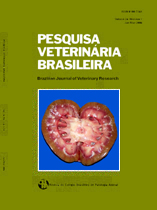 |
|
|
|
Year 2012 - Volume 32, Number 9
|

|
Standardization and evaluation of an indirect ELISA for the serological diagnosis of glanders in horses, 32(9):838-842
|
ABSTRACT.- Teles J.A.A., Campos A.C., Silva K.P.C., Santos A.S., Santana V.L.A., Castro R.S. & Mota R.A. 2012. [Standardization and evaluation of an indirect ELISA for the serological diagnosis of glanders in horses.] Desenvolvimento e avaliação de um teste ELISA indireto para o diagnóstico sorológico do mormo em equídeos. Pesquisa Veterinária Brasileira 32(9):838-842. Departamento de Medicina Veterinária, Universidade Federal Rural de Pernambuco, Av. Dom Manuel de Medeiros s/n, Dois Irmãos, Recife, PE 52171-900, Brazil. E-mail: rinaldo.mota@hotmail.com
Glanders is an infectious-contagious disease of acute or chronic character which principally affects horses, causing enormous losses in the productive chain of this animal. To control the disease, the Ministry of Agriculture, Husbandry and Supply instituted mandatory sanitation measures in the entire national territory which include an official diagnosis through the complement fixation (CF) test, maleinization and sacrifice of the animals that are positive. Nowadays the kits used for the diagnosis of the disease are imported, making their routine application difficult and more expensive. The objective of this study was to standardize an indirect ELISA test, using the proteic extract of Burkholderia mallei isolated from a carrier horse in the state of Pernambuco. The samples were cultivated in 10% blood agar and incubated for 48h at 37°C; later, one of the isolated colonies was characterized phenotypically and genotypically and immediately cultivated in brain heart infusion (BHI) for enrichment; then it was peaked (repicada) for the Dor-set Henley medium which was incubated at 37ºC under 60rpm for eight weeks. To standardize the test the Protein G Peroxidase Sigma Conjugate was used in the dilution of 1:90.000, with serums diluted in 1:100 and the antigen in 1:400. Sixty serums were used as negative controls, tested before the CF to determine the cutting point which was 0.042nm. After establishing the standardization, 300 samples were tested, of which 99% (297) were in agreement with the results obtained in the CF. At the end, of assay presented 100% sensibility and 98.2% specificity, with predictive (preditivo) positive and negative values of 97.7% and 100% respectively. The Kappa concordance test was 0.98 and the intra and interplac repeatability were 8.8% and 10.3% respectively. From the results obtained, it is possible to affirm that the indirect ELISA test can be used as an efficient diagnosis tool. However, more essays must be carried out to consolidate the reliability of this test. |
| |
|
|
| |
|
 |